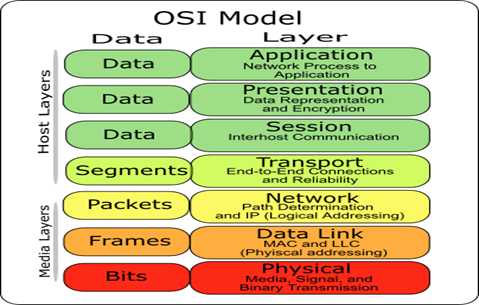Here we will see all different kind of Layer mechanism (OSI,DoD TCP/IP,Cisco Layers)
- OSI means Open System Interconnect Model
-Developed by IOS( International organization for standardization) in 1974

Now have closer look to OSI layer and method of remembering it very easily , please note here we will try only easy method of remembering all stuff out here.As no one have so long memory so I developed my easy methods hope it will help you out more.
Here 1st three layer is also known as SOFTWARE LAYER or UPPER LAYER( APPLICATION,PRESENTATION,SESSION) Where 2ed part means NETWORK,DATALINK PHYSICAL layer come in HARDWARE LAYER or LOWER LAYER.Where Transport layer is heart of OSI layer.
ok here is method to remember it.
1st method is
PLEASE DO NOT THROW SEXY PIZZA AWAY.......sound funny ha?
ok here is explanation
Please = physical Layer
Do = Data link Layer
Not = network Layer
throw = Transport Layer
Sexy =Session Layer
pizza = presentation Layer
Away = application layer
This I Called a reverse method from down to up.............
Ok now lets have look at another method.( thanks to altergothen)
All People Seem To Need Data Processing
Application ,Presentation ,Session ,Transport ,Network ,Data link ,Physical
See how easy to remember it?
ok now lets have look at which layer do what
| Layer | Responsible for | Task / Example
| TYPE |
Application Layer
(Layer-7) | - Providing network service to user,also known as Desktop Layer.Identified services using port numbers
| - Total no. of port 0-65535
- Reserved Port 0-1023
- Open Client port 1024-65535
- Example : WWW,R-login
| Data |
Presentation Layer
(Layer-6) | - Converting Data in to Standard Format
Example : ASCII,EBCIDIC,JPEG,MPEG,MIDI,MP3,WAV.
| - Encoding- Decoding
- Encryption - Decryption
- Compression-Decompression
| Data
|
Session Layer
(Layer 5)
(Connection) | - Negotiation,Establish and Maintaining connection( Session) with use of Session ID
- Keep different application at different session
- Simplex,Half Duplex,Full Duplex
| - RPC -Remote procedure call
- SQL- Structured Query Language
- NFS- Network File System
| Data |
Transport Layer
(Layer 4)
(Segment) | | - Identify Service
- multiplexing-De-multiplexing
- connection control(connectionless-connection oriented)
- network protocol (TCP/UPD)
- provide reliable ,unreliable Delivery
- segmenting,sequencing,re-assembling
- error control(error correction)
| Segment |
Network Layer
(Layer-3) | - Providing best path for data to reach the destination.
- provide logical addressing
- Define network segments and network schema
- Divided in to to parts
| - Routed protocol : IP,IPX,Apple Talk
- Routing protocol : RIP,IGRP,EIGRP,OSPF
| Packet |
Data Link Layer
(Layer-2) | - NIC(network interface card) create header and trailer
- Combine packet in to byte and byte in to frame
- Only error Detection
- Switch-bridge,NIC
| - Data link is Divided in to two sub-layer
- LLC (Logical Link Control) : WAN protocol : PPP ,HDLC,Frame-relay
- MAC(Media Access Control) : also known as physical address
| Frame |
Physical Layer
(Layer-1) | - Responsible for Tx And Rx bits
- Type of transmission
- Uni-Direction
- Bi-Direction
| - Device work at Physical Layer
| Bits |
Easy Right? ok Here is some of note which one is very very important to remember
Note.1: Error Detection : Data Link Layer (Layer 2)
Error Correction : Transport Layer( Layer 4)
Note.2: Flow Control - congestion Avoidance,Windowing,Buffering.
Ok now lets compare TCP and UDP
| TCP | UDP
|
- Transmission control protocol
- Connection Oriented
- Acknowledgement
- Reliable
- Slower
- Port no. 6
- Ex. HTTP,FTP,SMTP ,DNS
| - User Datagram Protocol
- Connection less
- No Acknowledgement
- Unreliable
- Faster
- Port no. 17
- DHCP,TFTP,DNS
|
- TCP Port no.
- Telnet =23
- SMTP=25
- HTTP=80
- FTP=20,21
- HTTPS=443*
- DNS=53*
| |
* Very important to remember for your CCNA exam
*Note : DNS is the only service which work on TCP and UDP with same port no.
Now Lets have look at DoD( Department of Defense) TCP/IP model
| Layer | Protocol
|
| Application Layer | Telnet,FTP,TFTP,LPD,SNMP,SMTP,NFS,X-WINDOW
|
| Transport Layer | TCP UDP
|
| Internet | ICMP,ARP,RARP,IP
|
| Network | Ethernet,Fast Ethernet,Token Ring,FDDI
|
Ok Now we are almost done Last but not least Comparison of Three model (OSI,DoD TCP/IP Model and Cisco Layer)
- Application Layer
- Presentation Layer
- Session Layer
| |
| | - Host-to-Host(Transport Layer)
|
- Data Link Layer
- Physical Layer
| |
Cisco have 3 layers Core,Distribution,and Access Layer(We will learn more about this later )
Here is some good video about OSI layer if you wish to learn more.
